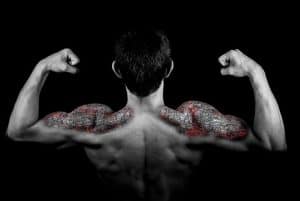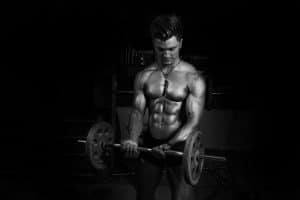Understanding Post-Workout Muscle Soreness

Part 1
Why does post-workout soreness occur?
People who lift weights on a regular basis know the feeling well. The pain often manifests twelve to twenty four hours after a heavy or intense workout. It affects all or nearly all of the major muscle regions that were used during the heavy workout… And the pain can be intense, too!
Delayed-onset muscle soreness or post-workout soreness is exceedingly common in the bodybuilding world. There are even “spray on” painkillers for people who can’t stand going about their day with stiff muscles. Many pop oral painkillers to eliminate the feeling but usually, the pain stays as long as it wants to.
It is believed that post-workout soreness can be caused by any or all of the following:
- Intense exercise
- Heavy resistance/load on the muscles.
- Micro-damage in the muscles, which encourages the body to enlarge and strengthen the muscle tissues
- Improper form during execution of exercises
- Insufficient or no warm-up exercises
Should you feel post-workout soreness every time you work out?
The simple answer to this essential question is no, you don’t have to feel intense pain every time you lift weights in the gym. Pain during a workout should be expected if you’re lifting near your maximum or if you’re working out for extended periods of time.
There is also a big difference between mild to moderate pain indicative of normal muscle development and extreme pain brought about by torn muscle or damaged ligaments.
Normal post-workout pain is often described as a dull pain that stays with you for a few days and disappears gradually until you barely remember that you had pain in the first place.
Injury-related pain is a class of its own. Muscle, joint or ligament injuries can generate a variety of pain signals from stabbing pain, gnawing pain or extreme, radiating pain that affects more than one spot or region.
Depending on the severity of the injury, the pain can fade on its own or it can intensify until it becomes unbearable and you need to rush to your physician for help.
As we’ve already discussed in previous articles, you have to be accustomed to pain if you want to make any real progress. Minor pain is actually a sign that your muscles are repairing themselves and your muscle tissues are becoming stronger and bigger.
The slogan “no pain, no gain” applies perfectly to bodybuilding. Every milestone you will be forever proud of is marked with some pain. The pain won’t be intense, but you will feel it nonetheless!
Who experiences post-workout pain?
All weightlifters experience some level of pain or discomfort after a workout. However, it is the novice bodybuilders who often experience the most intense post-workout pains. The reason for this is quite simple: novice bodybuilders have yet to develop strong muscles in all of the frequently used regions of their bodies.
If you’re a novice bodybuilder yourself, you will continue experiencing notable post-workout pain/soreness until such time that your body has become accustomed to the strain and load of weightlifting.
Some beginners experience severe post-workout soreness for several months while some only suffer intense muscle pain in the first two to three months of regular workouts.
Eventually, the intense bouts of pain will disappear and you will be able to progress to heavier weights without worrying about pain 24 hours after the heavy workout.
Is there a relationship between progress and post-workout pain?
Technically speaking, yes there is a relationship between the two. You see, moderate pain is your body’s way of telling you that great things are happening to your muscles.
In a way, pain is a sign that your workout is still helping your body develop.
If you experience absolutely no pain after a workout and soreness has become a thing of the past, it is possible that your body has fully adapted to your workout regimen and it is no longer changing to deal with the strain.
What usually follows is the dreaded “plateau.”
A plateau can affect a bodybuilder in two ways. First, it can result in regaining a small or moderate amount of body fat. This can be disastrous if you’re just starting to get the proper striations in your various muscle groups.
Second, a plateau can also halt your mass gains. Gaining additional muscle size and definition is hard enough – it can be doubly difficult if your body is no longer challenged by your workouts. Your muscles will not shrink or “turn into fat” but don’t expect any large gains any time soon!
Understanding Post-Workout Muscle Soreness
Part 2
How can you better manage post-workout soreness if you are serious about bodybuilding?
If you made a commitment to take your bodybuilding journey to its rightful conclusion then you definitely need a game plan for post-workout muscle soreness.
Some bodybuilders don’t mind the pain; if this fits your attitude about it then congratulations, you’ve overcome a major obstacle to progress.
However, if the opposite is true and the pain actually prevents you from lifting heavier weights or engaging in more strenuous movements then read on.
Managing Muscle Soreness
- Progressively Overload Your Muscles – If you’re thinking that we’re going to tell you to avoid pain, you’re mistaken.
Muscle pain is the twin brother of progress in bodybuilding. If you are no longer feeling sore at all after your workouts then your body has already adapted to your exercises.
As a rule of thumb, no weightlifting routine should be performed continuously for more than 1 ½ months. 1 ½ months is the maximal period for a particular series of movements.
After this period, change the movements or increase the total load your muscles are carrying so you can benefit from progressive overload.
Progressive overload is the act of continuously increasing the weight your muscles have to strain against during a workout.
For example, if you are currently benching 75 pounds, increase the weight to 90 pounds or 100 pounds if your chest muscles are no longer responding to 75 pounds.
Plateaus usually occur after a month or two. If you have become strong enough to bench 75 pounds with little difficulty, increase the load or risk a plateau.
How can you “shock” the body so you won’t suffer from a progress plateau?
Here are some easy ways to accomplish this:
- Increase reps, decrease sets
- Decrease reps, increase sets
- Increase weight or resistance
- Add new exercises
- Replace old exercises
- Increase the intensity of your cardio
- Increase the intensity of your weight training
By slowly and consistently increasing the resistance in your workouts or by tweaking other factors as stated above, you will be able to minimize the post-workout soreness while maximizing your mass gains. It’s important that you do not hamper your own progress in bodybuilding just because you’re afraid of pain.
As a bodybuilder, your musculoskeletal system is now conditioned to take on more physical stress than before. Don’t shy away from pain – manage it like the pros do!
- Listen to Your Body – You are the authority when it comes to determining whether you should work out or not while your muscles are still sore. If the pain is overwhelming and you can’t even move the affected area without wincing in pain then you may require a day or two of recovery.
However, if your muscles feel strong and only a little painful then it’s possible that your body is ready for more punishment. Again, bodybuilding changes your body and toughens it!
- Stretch Those Muscle Tissues – We know that lifting weights already feels like stretching because the muscles are in constant movement. However, you still need to perform stretching exercises if you want to reduce post-workout soreness.
Pre-workout and post-workout stretching sessions can improve the overall condition of your muscles by:
- Increasing blood flow or circulation to target muscle groups.
- Improving nutrient utilization in areas where micro-damage has occurred.
iii. Improving byproduct/waste transport from areas that receive the most strain or load during exercise.
Remember that muscle soreness is often attributed to the accumulation of lactic acid in our muscles. Lactic acid is considered a byproduct of natural biochemical processes that take place in the muscle cells themselves.
As long as there is a high amount of lactic acid in your muscles, you will feel sore. The body can remove the lactic acid naturally but it would be up to you to quicken the pace of the removal process.
- Turn to Quick Cardio Sessions for Comfort – Surprisingly, cardio sessions appear to have the same beneficial effects as stretching. A five to ten minute sprint on the treadmill can improve your overall muscle condition 24-48 hours after the actual workout. Try performing cardio at the beginning of your workout and right after the heaviest movements.
- Deep Tissue Massage Therapy – Deep tissue massage has long been a classical favorite of bodybuilders across the world. Touch therapy feels good but not only that – the body also benefits from improved circulation and better waste management. So if you have time to head over to a P.T. or massage clinic, why not indulge yourself after a heavy week?
You may also be interested in reading this very detailed and easy to follow guide on: Muscle Building Workout Plan For Beginners which will help you get started as a beginner.




